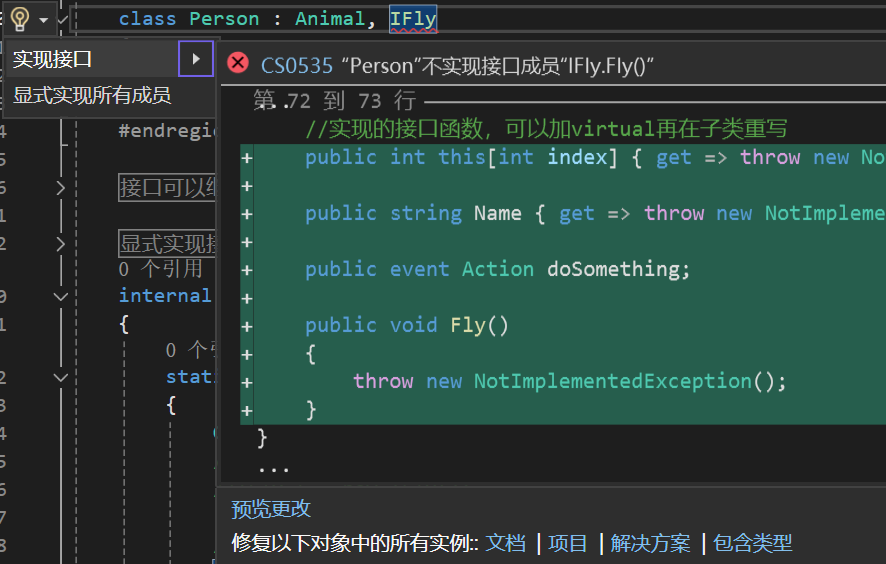CS3L20——接口
本章代码关键字
接口
接口是行为的抽象规范,它也是一种自定义类型,关键字:inferface
继承接口和继承类的区别
继承类 是对象间的继承 包括特征行为等
继承接口 是行为间的继承 继承接口的行为规范 按照规范去实现内容
由于接口也是遵循 里氏替换原则,所以可以用接口容器装对象,
接口内部只能包含成员方法、索引器、属性、事件,且都不实现,都没有访问修饰符,
类可以继承多个接口,但只能继承一个类
接口可以继承接口 相当于在进行行为合并 带子类继承时再去实现具体的行为
接口可以被显式实现 主要用于实现不同接口中的同名函数的不同表现
实现接口的方法 可以加 virtual 关键字 在之后的子类里重写
需要执行某种行为,就以行为对应的接口类型作为参数,传入拥有这种行为的对象(继承了对应接口的类对象)
因此实际开发中,建议多多使用接口抽象行为,通过接口类型变量接收具体类对象 ,通过接口调用方法
接口只规定一个类有什么行为,而不关心行为如何实现,因此相比继承基类,接口更灵活也更加解耦合(不会耦合基类的实现)
例如,飞 这种行为可以单独抽象成接口,
接口申明的规范:
不包含成员变量,只包含:方法、属性、索引器、事件,且成员不能被实现
成员可以不用写访问修饰符,不能是私有的
接口不能继承类,但可以继承另一个接口
接口的使用规范:
类可以继承多个接口
类继承接口后,必须实现接口中的所有成员
特点:
它与类的申明相似
接口是用来继承的
接口不能被实例化,但可以作为容器存储对象
C# 接口的更多特性可见:一期视频看透C#接口的全部特性及用法_哔哩哔哩_bilibili (注:Unity开发不能全部使用其中的介绍的特性)
关于接口和抽象类的区别,详见:CS3L27——抽象类和接口的区别
接口的声明
接口关键字:interface,接口可以认为是抽象行为 的基类,接口命名规范 帕斯卡前面加 I方法、属性、索引器、事件 ,成员不能被实现
声明示例:
1 2 3 4 5 6 7 8 interface IFly { void Fly () string Name { set ; get ; } int this [int index] { get ; set ; } event Action doSomething; }
接口的使用
接口用来继承,它表明某个类拥有这个接口的行为,接口也遵循里氏替换原则public 的virtual 再在子类重写
Visual Studio 可以点击灯泡图标里的实现接口来自动实现接口内的所有内容
1 2 3 4 5 6 7 8 9 10 11 12 13 14 15 16 17 18 19 20 21 22 23 24 25 26 27 28 29 class Animal { }class Person : Animal , IFly { public virtual void Fly () public string Name { get => Name; set => Name = value ; } public int this [int index] { get => 0 ; set => this [index] = value ; } public event Action doSomething; } internal class Program { static void Main (string [] args { IFly f = new Person(); } }
接口可以继承接口
接口继承接口时,不需要实现,待类继承接口后 类自己去实现所有内容
1 2 3 4 5 6 7 8 9 10 11 12 13 14 15 16 17 18 19 20 21 22 23 24 25 26 27 28 29 30 31 32 33 34 35 36 37 38 39 40 41 42 43 44 45 46 47 48 interface IWalk { void Walk () } interface IMove :IFly , IWalk { void Move () } class Test : IMove { public int this [int index] { get => throw new NotImplementedException(); set => throw new NotImplementedException(); } public string Name { get => throw new NotImplementedException(); set => throw new NotImplementedException(); } public event Action doSomething; public void Fly () { throw new NotImplementedException(); } public void Move () { throw new NotImplementedException(); } public void Walk () { throw new NotImplementedException(); } } internal class Program { static void Main (string [] args { IMove im = new Test(); IFly If = new Test(); IWalk iw = new Test(); Player p = new Player(); ISuperAtk isa = new Player(); IAtk ia = new Player(); } }
显式实现接口
当一个类继承两个接口,但是接口中存在着同名方法时,直接只实现一次同名方法是可以运行的,但是这样无法区分两个接口的区别
1 2 3 4 5 6 7 8 9 10 11 12 13 14 15 16 17 18 19 20 21 22 23 24 interface IAtk { void Atk () } interface ISuperAtk { void Atk () } class Player : IAtk , ISuperAtk { public void Atk () } internal class Program { static void Main (string [] args { Player p = new Player(); p.Atk() } }
如果需要区分两个接口的行为,为不同的接口分别实现不同的方法,则需要显式实现接口接口名.行为名 去实现
注意:显式实现接口时 不能写访问修饰符,如果接口里有方法是用 protected 修饰的也要用显式实现接口
显式实现接口后,接口的显式实现方法不能被直接点出来调用了,改成父类装子类或者用 as 来使用
指的一提的是,即使显式实现了多个接口的同名方法,这个方法和其他显式实现方法不构成重载! 因为它们本质上不是一个名字
1 2 3 4 5 6 7 8 9 10 11 12 13 14 15 16 17 18 19 20 21 22 23 24 25 26 27 28 29 30 31 32 33 34 35 36 37 38 39 40 41 42 43 44 45 46 interface IAtk { void Atk () } interface ISuperAtk { void Atk () } class Player : IAtk , ISuperAtk { void IAtk.Atk() { Console.WriteLine("显式实现IAtk的方法" ); } void ISuperAtk.Atk() { Console.WriteLine("显式实现ISuperAtk的方法" ); } public void Atk () { Console.WriteLine("不是显式实现的方法" ); } } internal class Program { static void Main (string [] args { Player p = new Player(); ISuperAtk isa = new Player(); IAtk ia = new Player(); p.Atk(); (p as IAtk).Atk(); (p as ISuperAtk).Atk(); isa.Atk(); ia.Atk(); } }
输出:
1 2 3 4 5 不是显式实现的方法 显式实现IAtk的方法 显式实现ISuperAtk的方法 显式实现ISuperAtk的方法 显式实现IAtk的方法

